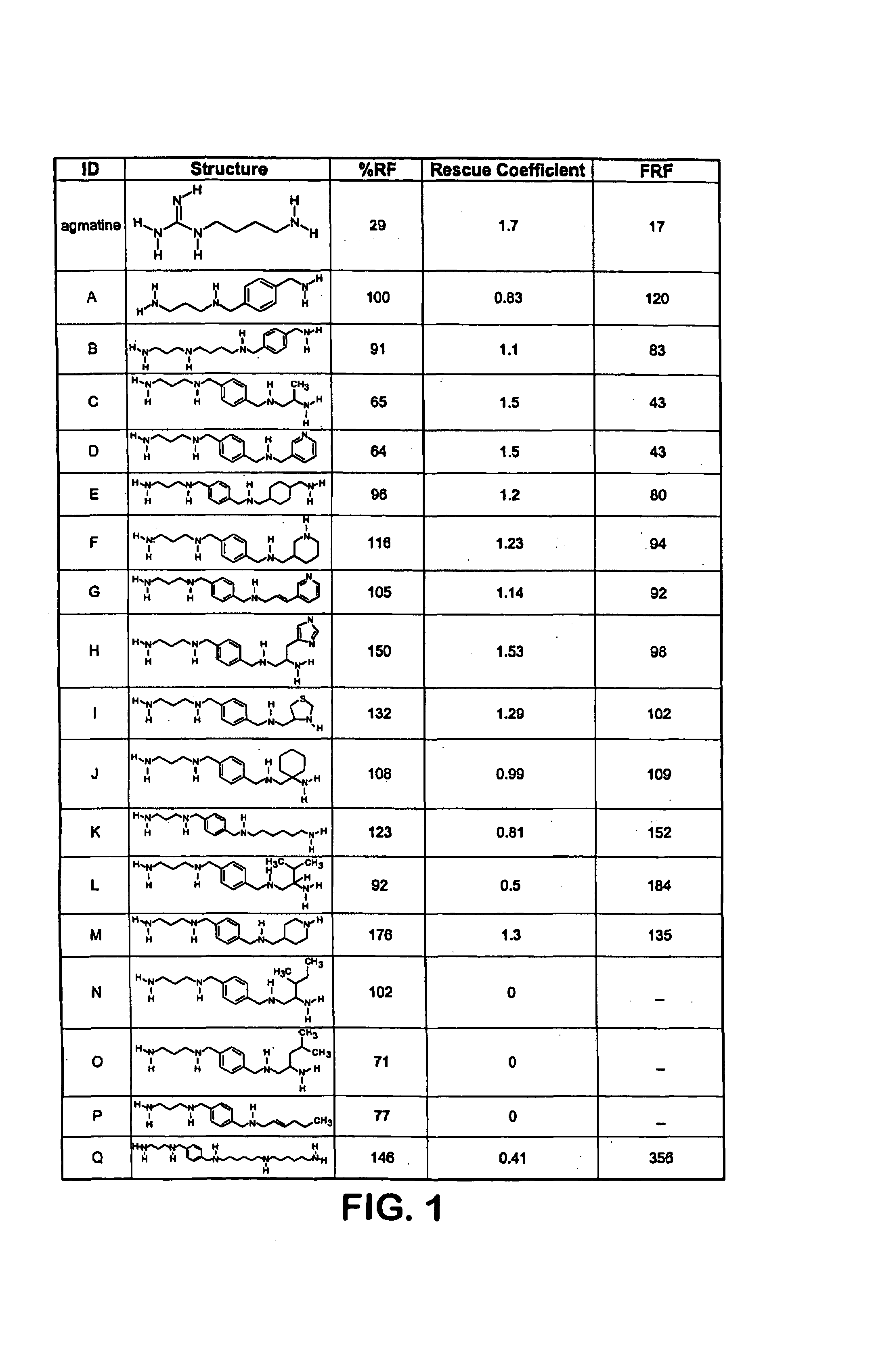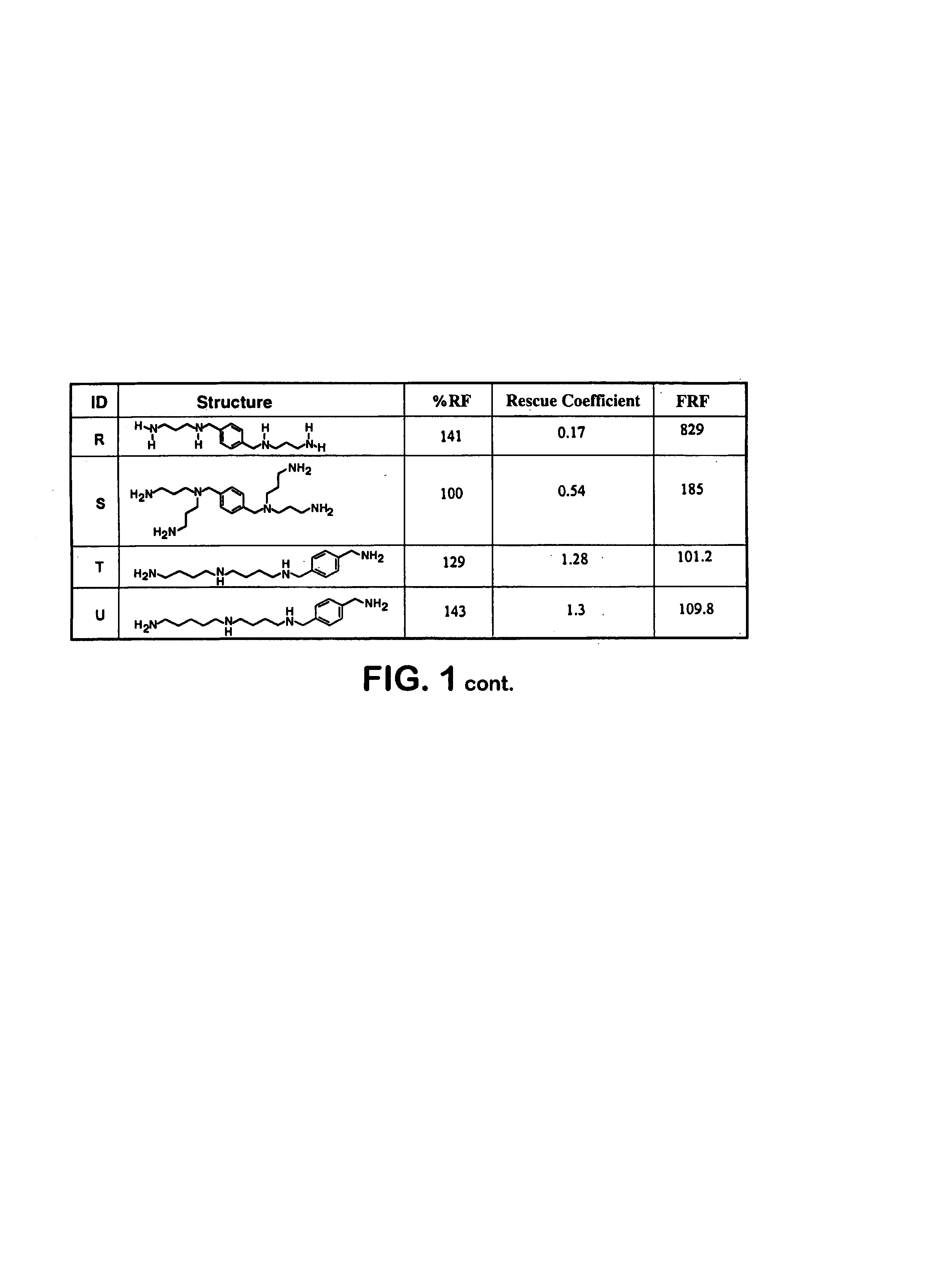Polyamine analogs that activate antizyme frameshifting
a polyamine analog and frameshifting technology, applied in the field of polyamines, can solve the problems of negatively affecting the induction of antizyme, observed cytotoxicity, excessive skin folding, etc., and achieve the effect of increasing the full length antizyme protein level and effective therapy
- Summary
- Abstract
- Description
- Claims
- Application Information
AI Technical Summary
Benefits of technology
Problems solved by technology
Method used
Image
Examples
example 1
Synthesis of Compound A
[0109]N-(2-cyanoethyl)-xylylenediamine (1.1)—To the slightly cloudy solution of 6.81 g (50 mmoL) of p-xylylenediamine [539–48–0] in 250 mL of dry CH3OH is added 3.95 mL (3.18 g, 60 mmol, 1.2 equiv.) of acrylonitrile dropwise at 25° C. under an atmosphere of argon. The reaction flask is shielded from light and allowed to stir for 5 h. Thin layer chromatography (CHCl3:iPrOH:concd. NH4OH 80 / 18 / 2) shows a mixture of di-(2-cyanoethyl) product (Rf=0.63) and mono-(2-cyanoethyl) product (Rf=0.26) materials is formed. Only a slight trace of p-xylylenediamine (Rf=0.02) remains. The solvents are evaporated and the resulting oil is purified by silica gel chromatography using the following ratios of CHCl3:iPrOH:concd. NH4OH: 85 / 13 / 2 (1 L), 80 / 18 / 2 (1 L) then 75:23:2 (1 L) to give 3.90 g (32%) of the di-(2-cyanoethyl) product as a white solid. The desired mono-(2-cyanoethyl) product eluted in later column fractions and weighs 3.06 g (32%) as a colorless oil.
[0110]N-(3-amino...
example 2
Synthesis of Compound B
[0111]Resin 2.2—To a 100 mL solid-phase peptide synthesis vessel containing 10 g (Rapp Polymere, 14 mmole, 1.4 mmole / g) of polystyrene-based trityl chloride resin in 30 mL of CH2Cl2 is added a solution of 19.07 g (140 mmole, 10 equiv) of p-xylylenediamine in 30 mL of CH2Cl2 dropwise at 25° C. over 30 min. During this addition the resin is agitated via the introduction of a slow stream of argon through the bottom frit of the vessel. Copious amounts of white precipitate form over the course of the 8 h reaction. Following this time the resin is filtered and washed with CH2Cl2, iPrOH, DMF, THF then CH2Cl2 (3×75 mL each). The dried resin is treated with 10 mL of diethylamine in 40 mL of CH2Cl2 for 2 h to completely cap the resin. The same washing procedure as above followed by a thorough overnight vacuum drying process takes place to give the product resin. This resin gives a positive Kaiser amine test reaction.
[0112]Resin 2.3—All of the resin from the step are sus...
example 3
Synthesis of Compound C
[0121]Resin 4.3—To 0.5 g of Resin 4.2 and 0.55 g (3 equiv) of triphenylphosphine suspended in 10 mL of dry THF is added 0.43 g of 2-methyl-2-phthalimido-1-ethanol produced via the route shown in FIG. 10 (other compounds in FIG. 1 are produced by use of the appropriate precursor molecule). To the resulting suspension is added 0.42 g of diisopropyl-azodicarboxylate dropwise at room temperature over 45 min. The resin is agitated over the next 18 h by the introduction of a slow stream of argon through the bottom frit of the vessel. After this time the resin is filtered and washed with CH2Cl2, iPrOH, DMF, THF then CH2Cl2 (3×25 mL each). The resin gives a negative Kaiser amine test.
[0122]N-(3-aminopropyl)-N′-(2-methyl-2-aminoethyl)-1,4-xylylenediamine (Compound C)—To a 0.25 gram portion of Resin 4.2 obtained above is added 10 mL each of EtOH and hydrazine hydrate. The resin is heated at 60° C. for 18 as for Resin 2.5 above. After 18 h at this temperature the vessel ...
PUM
| Property | Measurement | Unit |
|---|---|---|
| cell turnover time | aaaaa | aaaaa |
| volume | aaaaa | aaaaa |
| weight | aaaaa | aaaaa |
Abstract
Description
Claims
Application Information
 Login to View More
Login to View More - R&D
- Intellectual Property
- Life Sciences
- Materials
- Tech Scout
- Unparalleled Data Quality
- Higher Quality Content
- 60% Fewer Hallucinations
Browse by: Latest US Patents, China's latest patents, Technical Efficacy Thesaurus, Application Domain, Technology Topic, Popular Technical Reports.
© 2025 PatSnap. All rights reserved.Legal|Privacy policy|Modern Slavery Act Transparency Statement|Sitemap|About US| Contact US: help@patsnap.com



